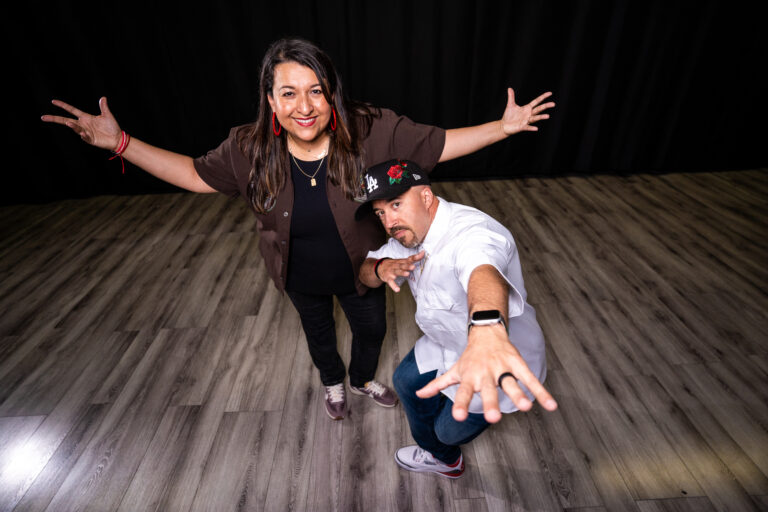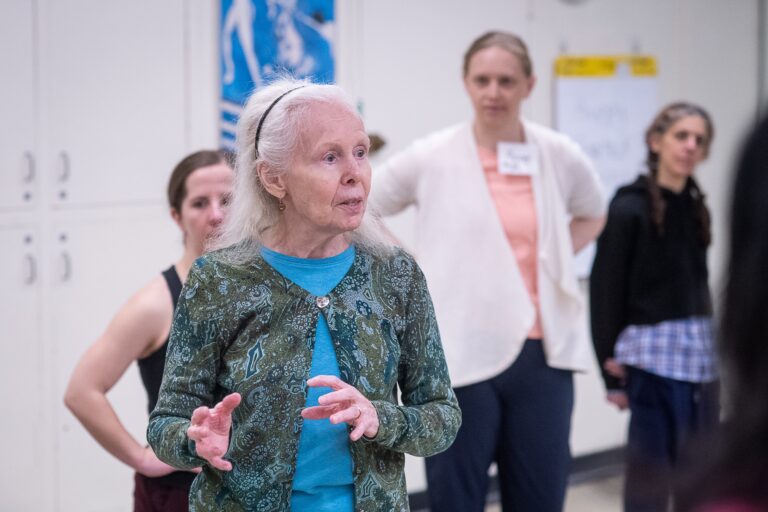Five disaster scenarios and their antidotes
Students in Queen City Ballet’s “Nutcracker”
When it comes to the big show, most studio and school directors pride themselves on being as organized and in control as a four-star general to keep things from running off the rails. But from costume mishaps to little angel meltdowns to tech snafus, disasters of any size and scale can strike during the run-up to a production. What are the biggest hurdles a director faces when putting together a performance, and what can you do to keep things on track?
Lights Out
“I’ve been doing this for a long time, and it doesn’t necessarily get easier,” says Campbell Midgley, who has run Queen City Ballet in Montana for 12 years. “I keep doing the same thing over and over again expecting a different result, so I guess I’m insane!”
Midgley, who calls herself a Nutcracker masochist, is among the legions of dance directors who will embark on holiday performances this month. Usually, she says, she feels like her dancers are well-prepared—it’s the technical side of things that gives her the willies.
She recalls one terrifying show in which, an hour and a half before curtain, the lighting director lost all of the cues they had labored over for hours. “I was thinking we might as well do the show in the parking lot,” she says ruefully.
Midgley remembers flying by the seat of their pants, quickly setting some basic cues that they could use through the show, and from there, as she puts it, they winged it. “It was the most stressful thing I have ever done in my life,” she says.“Literally, after the show, it felt like I and the lighting guy had just given birth.”
Midgley advises making sure you take good notes while going through the tech rehearsals. She makes up meticulous cue sheets for each show, which come in handy for shows like Nutcracker that are produced every year. “I’ll write down to the minute if it’s an eight-second grow, or a zero-count,” she explains, “and if it’s recorded music I’ll note in the times. I’m a freaking perfectionist—I put it all into an Excel spreadsheet.
“And I always have two copies of the music,” she says, adding that even with all the preparation in the world: “It’s still live theater, and live theater comes with uncertainty.”
Backstage Drama
After 30 years of Nutcrackers, Kathleen Sinclair of Ballet Yuma in Arizona has been staging the production for so long, she almost can’t remember those early days when they were still figuring out how to manage the chaos.
Her number-one priority is making sure she has a terrific person backstage overseeing everything—and with 75–90 children involved in the show, not to mention a score of company dancers, that can be no mean feat. “You need a superwoman down there,” she says, “someone who can organize the volunteers, take care of the children’s room and keep everything going smoothly. When you have one of those, you don’t have to worry about what’s happening on that side of the production, and you can concentrate on what’s happening onstage.”
Sinclair recruits 15 moms and dads to work backstage and tries to keep her key people from one year to the next. “I’m always looking for someone who has leadership qualities, who can take charge and problem-solve,” she says. “I’ll try to move them up into a more supervisory position. That way, I know if a problem comes up backstage, they’ll handle it; they can figure it out without coming to me about every little eyelash.”
Problems can range from the minor to the serious. Keeping even a few rambunctious young boys under control can be difficult. One year, Sinclair’s son slid off a staircase bannister while playing around and had to be medevac-ed to Phoenix with a head injury.
“I tell the boys that story every year,” she says. “That bannister is still there in the theater, but that story scares them and we never have a problem. They take their time walking down the stairs.” Now, she and the volunteers make sure that the boys stay corralled in the dressing rooms. “We put DVDs and video games in there to keep them occupied,” she says, “and they sit in that room really happily.”
Dressing
Clockwork precision is what makes a seamless production possible for the California Academy of Performing Arts in Moraga, California. Over 20 years, veteran artistic director Joan Robinson Borchers has honed a system to get 200 kids to the right place at the right time.
CAPA performs in a local high school theater with a dressing room that accommodates the older girls who dance the major roles, as well as “Snow” and “Waltz of the Flowers.” But there’s no room backstage for the hundreds of bon-bons, angels and candy canes to wait to go on, much less get dressed and made up. So larger groups of kids in CAPA’s Nutcracker dress in a multipurpose room in one of the high school’s other buildings. In a kind of “in the hole, on deck, at bat” system, parent volunteers are assigned to keep the dancers on schedule, walking them over to the theater at the appointed time.
“In the dressing rooms, they have the lineup of exactly when the dances happen in the show, and how far in advance they have to get to backstage,” Borchers says. “If the show starts at 7 pm, and there’s a dance that occurs at 7:50, the dancers have to be backstage by 7:45, and they know when they have to leave and how long it takes to walk across the drive to get there. We have that all down to a science.”
If that sounds like a painstaking level of detail, perhaps it’s because that system is simple compared to what they have to do during the weekday student matinees when the high school’s multipurpose room isn’t available. For those shows, the dancers dress and get made up at the dance studio half a mile away from the theater, and then rented buses shuttle them at the appointed times to the theater and return them after they are done. “It’s a huge, complex operation that requires enormous parental cooperation to make it work,” she says. “But it does work.”
Of course, even with all that organization, mishaps can happen. “Many years ago, we had a girl—a brilliant dancer, but a real airhead,” says Borchers. “She came out as the Sugar Plum Fairy with no tights on.”
To ensure that the kids make it onstage with all their costume pieces on, Borchers and her wardrobe volunteers instituted a clever system that works especially well for quick changes. “Each dancer has two shopping bags each with their names written on them,” she says. “In one is the costume they have to get into, with the pieces arranged in the order they’ll need to put it on. The other bag is empty, and it’s where they put what they take off. It’s a great way to not have a pile of costumes backstage and kids running around saying, ‘I can’t find my shoes,’ or ‘Somebody took my headpiece.’”
Partnering
“You can’t do it all by yourself,” says Jane Venezia, director of the Stage Door Dance Studio and its performing company, Central Washington Dance Ensemble, in Ellensburg, Washington. “The parents have to be on board from the beginning, to serve on committees and help with props and scenery, makeup, supervising the dancers, selling tickets. Once they agree it’s a family project, you have your support team.”
This year, the ensemble is partnering with the Central Washington University on their first full-length production of The Nutcracker. “We’re able to use their theater and tech crew to run everything,” Venezia says, adding that the connection also helps alleviate the perennial challenge of finding guys to dance. “They have a dance minor program, and I’ll sometimes be able to get a couple of guys who are musical theater majors to do simple partnering.”
Like many directors, Venezia has everyone hunting in nooks and crannies to find boys for The Nutcracker. “We have one teacher whose son is on a soccer team. She went to a team meeting and asked if any of the boys would perform in the party scene. They can move—and change direction fast,” she says with a laugh. “It adds a different dynamic to the production.
“Another family has two sons who took hip hop and we recruited them,” she adds. “There’s less of a stigma to it because it is Nutcracker. They get to be boys and they don’t have to wear tights.”
Shortage of Boys
Bonnie Schuetz, who directs Boni’s Dance & Performing Arts Studio in The Woodlands, Texas, has neatly solved the man-shortage problem while also finding a way to make things easier on her littlest dancers. In her year-end recitals, she choreographs “Daddy Dances” for the 2- and 3-year-olds.
“Their mommies rehearse with them,” she explains, “then we do two or three weekend rehearsals where the dads come in. The group might start out onstage on their own, and the daddies come out halfway through the number. They’ll partner them—maybe the dad will go down on one knee and the little one will hold a hand, walk around them and end sitting on his knee. Or they might do a fish, or the daddies lift them and do shoulder sits.”
At the end, Schuetz says, the fathers pick up the little ones and take them offstage, which winds up being both adorable and practical, since it helps reduce the chaos of trying to organize the children backstage.
“They don’t really dance much, but it’s a neat experience for those daddies,” she says wistfully. “Sometimes I’ll have guys come up to me afterward and say, ‘I want to be in the classes where the daddies dance with the daughters.’”
Schuetz also uses dads in her senior ballet partnering classes where she might have two dozen girls and not enough boys. “I’ll teach them very simple things, a finger turn, a penchée, a promenade. They might get a little bit of pirouettes,” she says. “Dads love it, and the moms come and watch from the window.”
And the fathers get to play one more role as the girls get to the advanced level. “My seniors, they’ve all done the daddy dances, and so when they perform their senior choreography, afterward these 18-year-olds finish,” she says, choking up a little, “and their daddies come and escort them off the stage.” DT
Mary Ellen Hunt, a former dancer, now a teacher, writes about dance and the arts for the San Francisco Chronicle.
Photo by Kaitlyn Broderick



